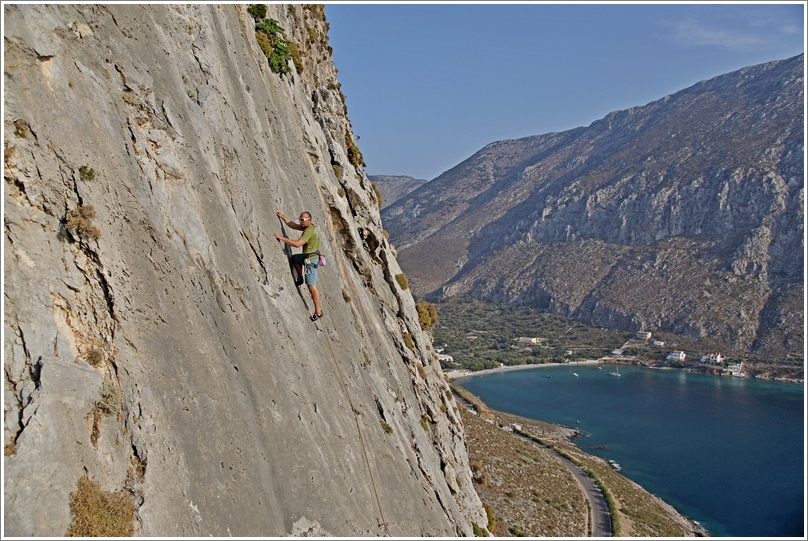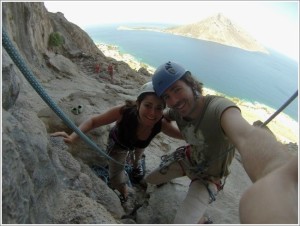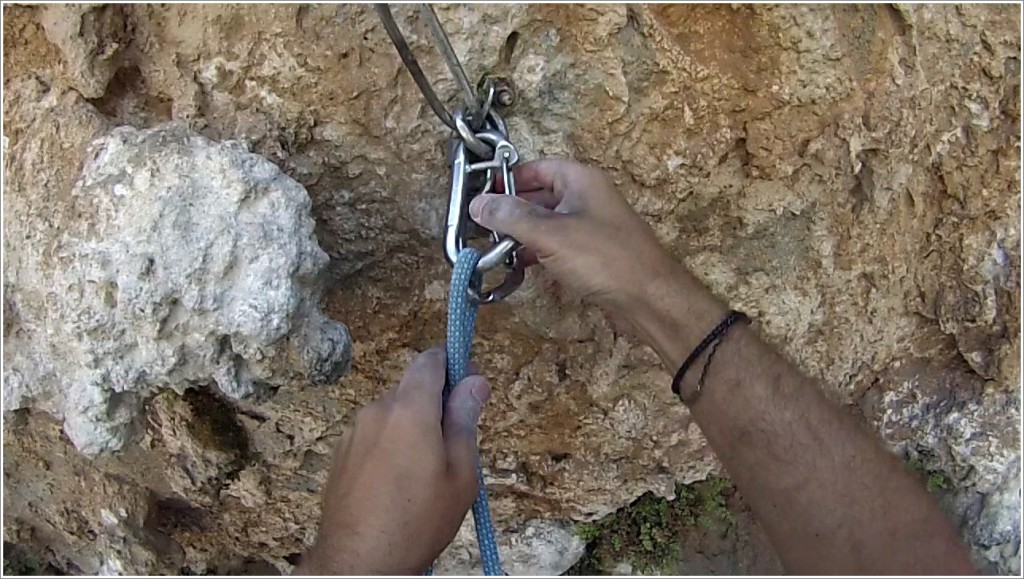
A paradise indeed…Here, Urs Odermatt climbs “Dodo” 6a+ at sector Belgian Chocolates. Photo: Aris Theodoropoulos
Hi everyone! How is summer treating you? We have been inactive for a while, but we are back today with a guest post written by two climbers who visited Kalymnos for the first time this summer, Angelos and Vuslat. It is about anchor safety, an issue we have addressed before, both in the guidebook and here on Climb Kalymnos. When we wrote about it a while back, the comments by readers were overwhelmingly in favor of using two-ring anchors instead of clippable carabiners. However, after the first tragic fatal accident happened in Kalymnos last year due to errors while untying/re-threading at a two-ring anchor (by a very experienced climber), we stand even firmer in our conviction that clippable lower-offs are the best solution for Kalymnos. Below, Angelos and Vuslat write about how we can help prolong the life of anchor hardware and ensure every climber’s safety. It affects every one of us and the solution is quite simple. (And please forgive our absence from Climb Kalymnos these past few months. We are holed up in our offices finishing the all-new Kalymnos guidebook, and trying to get it published by late September. Updates to follow soon.)
Many, many thanks to Angelos and Vuslat for stepping in, and we hope you are all enjoying life wherever you are!
_____
A Climber’s Paradise: What Can We do to Keep it Safe?
What makes Kalymnos an indisputable paradise for climbers worldwide is its limitless and beautiful crag options, each with breathtaking views of the island’s spectacular nature surroundings. Another feature that is perhaps even more important to note, though often undermined, is the safety of the crags.
When we visited the island for the first time this summer, we noticed and appreciated how each and every project was carefully bolted, equipped, and maintained—a truly notable achievement since there are only a handful of people who have taken it upon themselves to maintain the island’s 2000+ routes, and to update visitor information for the safety and benefit of all climbers.
We were thus disappointed to see, one after the other, climbers from all around the world and of all ages and levels, failing to respect the safety gears in-place: routinely, climbers around us were simply clipping their ropes on the established lower-offs without placing a single anchoring equipment of their own, and using the permanent gear for their large group of friends to top-rope on. Indeed, many of the fixed carabiners had substantial wear-and-tear, some with over 50 % of damage caused by ropes eating through the metal over time (Photo 1).
Out of curiosity, we walked around various crags and spoke to neighboring climbers over the course of a week to see how they were doing things. It occurred to us that the vast majority of tourist climbers did not understand why top-roping on permanent gear risks not only their safety, but also the safety of other climbers.
All of this is easily preventable.
Anchoring, as we should all know, is one of the most basic safety measures in climbing.
Building your own anchor or enhancing the already set up anchor when top-roping outdoors is not just important; it’s imperative. Nobody wants to finish climbing a nice project only to see the fixed carabiners at the anchor in a dangerous state. Simply put: YOUR safety and everybody else’s SAFETY MATTERS.
If you lead a route and want to set the anchor for your group to top-rope on, then that makes you responsible for THEIR safety as well as YOURS. So, be responsible and devote a few more minutes to set a suitable and safe top-rope anchor that removes the load from the permanent carabiners. There are many ways to set a top-rope anchor and the Kalymnos guidebook explains some of them. For example, adding a couple of quickdraws or even a single locking carabiner to the anchor can be an easy and safe solution (Photo 2).
Here’s a quick guide:
Clip the rope onto the fixed carabiners when you are at the top of the route. Place 2 short quickdraws with at least one locking carabiner with their gates opposite and opposed, above the fixed carabiners and onto the bolts. Clip the rope to your own quickdraws as well. Notice the direction of pull and make sure the anchor weight is equalized. In this way, the weight gets distributed through both quickdraws without overloading the permanent gear, thus prolonging the life of the fixed carabiners. In some cases, you can use one quickdraw or even combine quickdraws with locking carabiners to set an anchor and remove the load off the fixed carabiners. Once your group is finished with top-roping, remove only your quickdraws from the anchor, but leave the rope running through the permanent lower-offs so that you can lower-off safely. The use of a Personal Anchoring System (PAS) throughout the whole anchoring and removal of the equipment is advised. (Admin’s note: This applies not only to top-roping but to leading routes as well. When you are projecting a route, i.e. you know you will leave your gear in place and try it repeatedly, or when several people in your party want to lead the same route, leave extra gear at the anchor and remove it after your final attempt.)
We all come to Kalymnos for the diversity and the quality of the routes, and to have fun on this beautiful island. Aris and his team are doing a commendable job maintaining the crags as they rebolt over 100 projects annually. Let’s now do our own part to keep Kalymnos safe and fun for everyone.
Till next time, climb on!
Angelos Katsanis & Vuslat Demirkoparan
_____
About the authors:

Angelos Katsanis is a researcher in Evolutionary Ecology at University of California, Irvine. Besides chasing after insects in the field, he is passionate about climbing.
Vuslat Demirkoparan is a Visiting Professor in the Writing Program at Soka University of America. Her newfound interest in climbing makes her wonder why she didn’t start this sport sooner.
Both authors live in California, USA, and enjoy climbing outdoors especially in Joshua Tree, Yosemite, and from now on, Kalymnos! During the weekdays, they enjoy climbing at Chris Sharma’s climbing gym, Sender One, where they also discuss climbing safety with its certified staff.





7 Comments
We have gone over and over again this issue.
Climbers are cheap. All of them, gym rats, or outdoor climbers. They are bloody cheap persons.
Somebody mentioned Italians: I am italian. The gym community of italians is extremely small, they chance they were gym rats is minimal, so they just were ignoring what they told them, because they are cheap. It’s very common for italians to do toprope, girls/women in particular.
Unfortunately, belays are made in two ways: to be use with a carabiner (one ring) or to be used as a lower off (best two rings, acceptable with a “twisted” hanger and one ring). But if you have most belays with one ring, removing the carabiner make the rope to scratch like hell. Most climbers, if they leave a biner, it’s junk, or aluminum, that will corrode in days in Kaly. If you want to get rid of carabiners, I suggest you to start not by routes, but by cliffs. Example: replace all belays with carabiner with a two ring belay in one place. I can volunteer if you want. So everybody going there will quickly realize how to tread the rope, or will change the cliff. And you have only ONE place to go there to “inspect” and remove ALL left gear. Do it in 3/4 places. Simple. The listen to comments.
Best,
E
PS Aris: Advise if I need to carry a pray to untighten nuts. I think It will not be easy to find it in Kaly.
I have a slightly different opinion on that issue. Not for bragging, but for putting things into perspective: I’m an active equipper who has put up a few routes on Kaly and many more elsewhere. I spend around ~1k Euro/year for bolts, belays and other fixed gear which I leave for other climbers.
In the first place, the issue with worn lower-off-carabiner on Kaly cannot be blamed to toproping. I’ve hardly seen anyone toproping on Kaly at all, the steep terrain just is not suitable for that, plus the routes are well protected. And since most climbers just do one single go per route, the wear is just from the regular lower-off process.
Second, I always leave a biner on top of single pitch routes which I equip. A steel carabiner costs ~10 Euro and lasts for at least 1000 people who are lowering-off. This makes a whopping 0.01 Euro per person – an absolutely ridiculous amount if compared against the cost for a trip to Kaly, for the usual wear and tear on personal gear, to the amount that most people spend for climbing gyms, et cetera. Of course I know how to thread a belay, but I just like to convenience to just clip and strip – it is not totally free, but almost. Suggesting people should rappel rather than lower-off (on steep Kaly routes?) just to save 1 Cent seems totally unrealistic to me.
The problem with worn gear in my opinion is more one of people expecting that the fixed gear just grows out of the rock and that there is “somebody” who controls and maintains the stuff, ideally for free. People should be encouraged to contribute, be it either by handing out some money, or even better by replacing lower-off carabiners they find in a worn state by themselves. If everybody was just doing that, the issue wouldn’t exist. And hey, it’s really not a big deal to buy a few steel carabiners which you can leave if you encounter a badly worn one at a belay.
i agree at 100% wiyh you … biners at the belay is not a good think for security! for me it is just the opposite … carabiners belay are dangerous as they wear out quickly and it is impossible to check them all
If gym climbers are so stupid that they can not make handling at the belay … they stay in their gyms!
The mentioned article of Mauriziois about redundancy and safety for the final lowering off/abseiling.
I just spent a week on Kalymnos and I refuse the opinion that it’s only novice climbers that use the provided biners for top-roping or repeated lower offs. I’ve seen 7a/7b climbers that never user their own gear at the top. I’ve seen Austrian guides that top-roped (with a large group) on only one in-situ biner! I’ve seen large groups of Italians and Russians top-roping on several times on many routes. IT’S DEFINETLY NOT something that is taught to people otherwise there would be differences from different countries (each alpine association as it’s own educational style)
One guy does the lead. The rest of the group tries it on top-rope (8-10 times). Communication was impossible. Even after showing the pictures in the guidebook.
In my opinion it is something the generation “climbing gym” is totally unaware of. Nobody has to untie in a gym.
The only option is in my opinion: don’t create an outdoor gym. There are certain things a climber has to know when climbing outside. Threading a rope through a ring is as essential than tying into the harness. This is the only way to force people to learn the simple steps of descending without a biner.
Security does not count as a counter argument. What if a climber reaches a belay without a biner (e.g. theft) or a very worn biner. If he doesn’t know what to do his best option would be to leave some gear at the top. But I would bet that 80% would use the worn biner if there is one.
Rock climbers have to know more than gym climbers e.g. judging bolts, rocks can be loose,…
CU
Markus
Hi guys
As a route equipper, and the founder of Safer Cliffs Queensland, a rebolting fund, I 100% support this article. Climbers _should_ only toprope through their own quickdraws. In Australia, toproping directly through the anchor is a universally condemned practice. Unfortunately, there is a problem.
Guides, in Europe (and many other places) set their clients up to toprope directly through the anchor because they believe it removes the need to teach novices how to re-thread, and removes one potential risk from the climbing day (which is true). The well-respected Planetmountain just published an article from Maurizio Oviglia recommending people do exactly that. I couldn’t believe it. Link: http://bit.ly/1QqWaIo
This leads novice climbers to think that “it’s okay” to toprope directly through the anchors. We then will have a climbing population that thinks it is okay. It is NOT okay!
Novices need to be taught to re-thread an anchor at the same time they are shown how to put on a harness and tie a figure 8.
Cheers
Lee
What is the point in the extra expense and worry of setting permanent biners in the first place? Why not just set rings and not give people who don’t know better the option of endangering themselves and others?
Thank you Angelos and Vuslat!
Too many people still use the fixed material. Years ago we too didn’t know the importance of using your own material, but since somebody told us about it, we always do. And we teach everybody we climb with.
It all comes down to education!So spread the word.